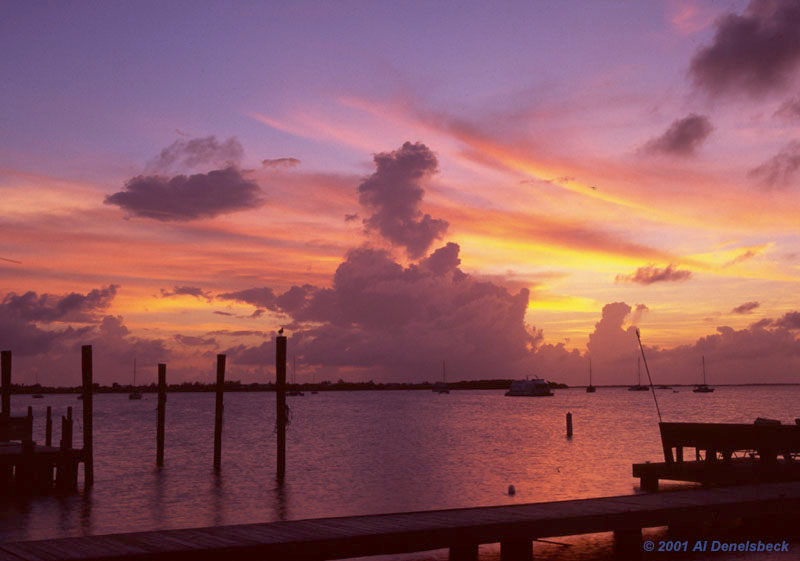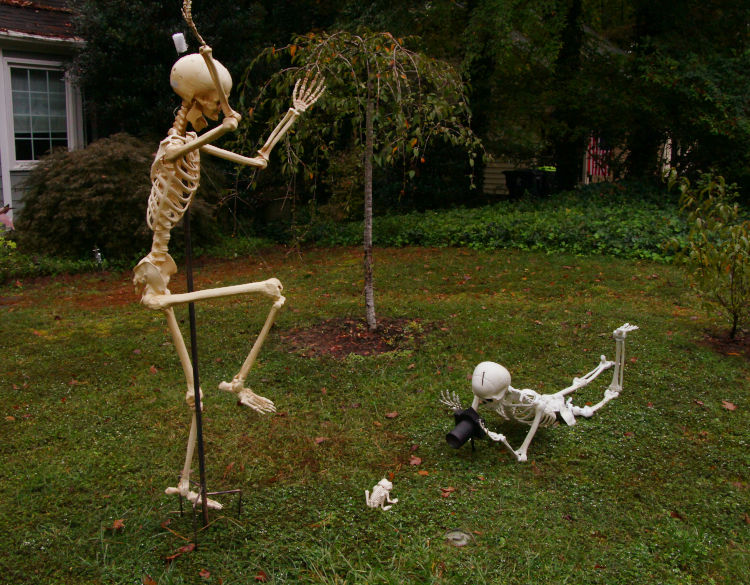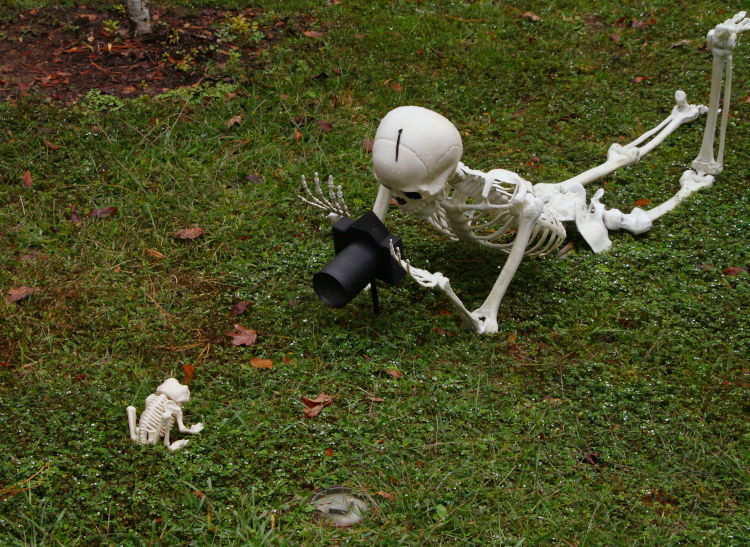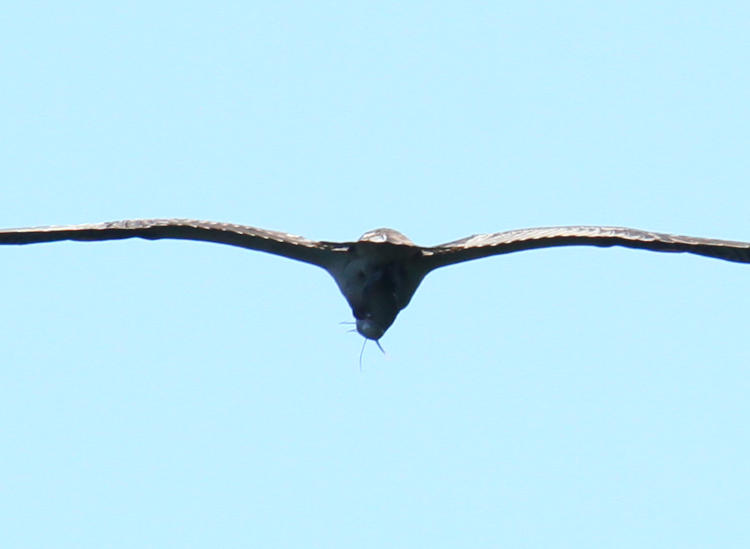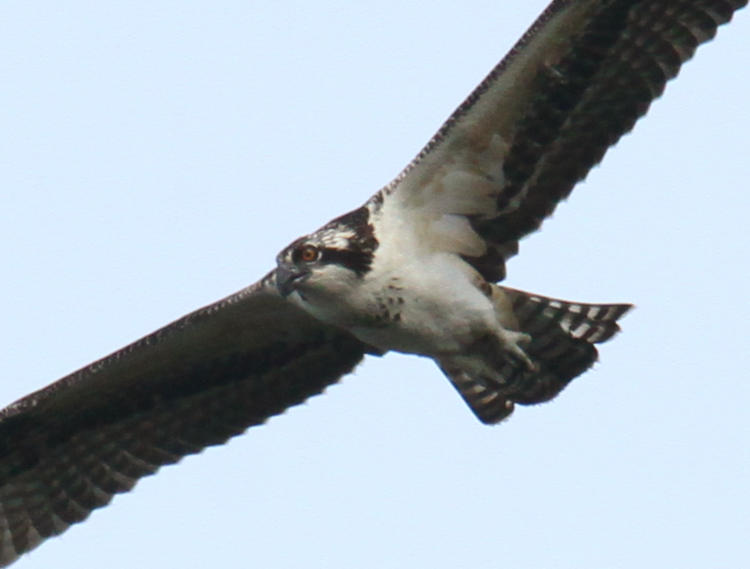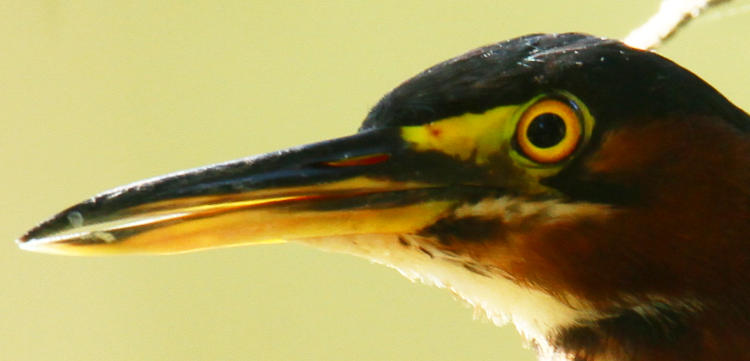Yeah yeah, I know, terribly unprofessional of me to neglect the blog, but I’ll tell you what: you can keep my honorarium this month. Deal?
That aside, I did indeed take a few photos yesterday, which means only an hour or two ago. It’s a clear night.

I’d seen the moon last night, uh, two nights ago, and knew it was too soon for… you know… so kept it in mind for tonight, uh, last night, whatever. But the key moment fell sometime during the day it appears, because Tycho is fully illuminated here – it is the distinctly round crater at lower left, well beyond the terminator. Though as I examined the photos, I thought I’d check and see what other craters might be seeing sunrise on their central peaks, if any. And now we focus on Bullialdus, the one that sits by itself in the dark mare southwest of center (not the one centered along the terminator, with light catching its floor – that’s Archimedes.) Let’s take a closer look.
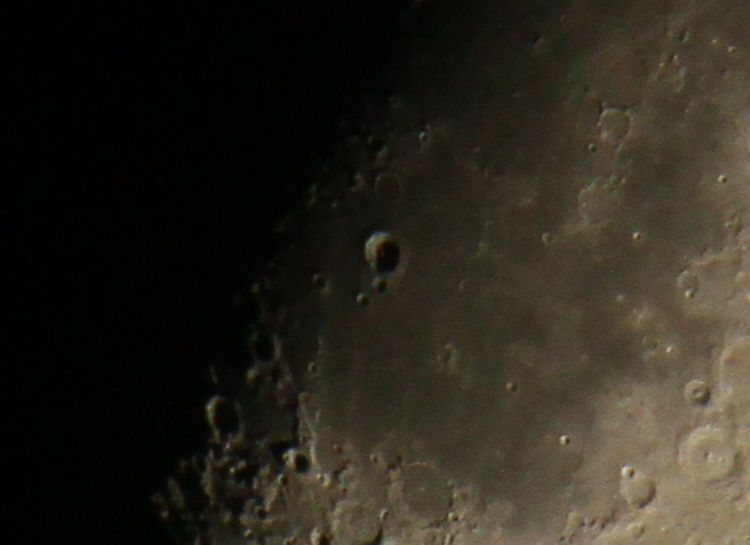
This is at full resolution, at roughly 1000mm focal length (the Tamron 150-600mm with the not-quite-2x teleconverter,) with Bullialdus centered. And yes, it seems there might be a hint of a light spot centered in the crater, but it’s not conclusive.
So I waited a half hour, and went out again.

I made the mistake of not noting my previous exposure when I went back out, and had been changing the settings drastically for reasons that will soon become apparent. So this shot is slightly less exposed than the previous, though it does seem to confirm that the first hint of sunrise is catching the peak in the center (which is not as distinct as Tycho’s, but hey.) For comparison, Bullialdus is about 61 km across and has a central peak system that rises a little over a kilometer, while Tycho is 85 km across with its peaks rising 1.6 km. Bullialdus is older and more degraded, but it’s not clear if astronomers have any real idea how old it is – younger than the mare it sits within, obviously, but that doesn’t narrow it down much.
But because of this exposure boo-boo, I went out again to do a bit better.

Yep, it’s clear – it’s sunrise on Bullialdus’ peak, and appears to be just happening as I took these shots. Now granted, had you been standing there you would have seen the sun break the lunar horizon some time before, hours perhaps – it’s going to be a while after first light before enough is reflected from the peak to be seen from Earth, but this is what I got with what I got, equipment-wise. Which is not quite true: I have a semi-decent telescope that would do a much better job, but I have yet to get off my ass and get it in spec. It almost happened tonight, because there were multiple things to be seen, but laziness prevailed.
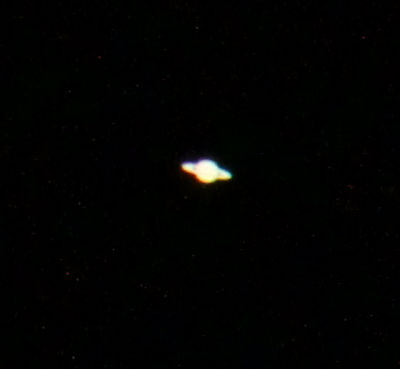 I had checked Stellarium before I went out, to be sure I wasn’t missing something cool like the ISS passing in front of the moon, and so I knew that the semi-bright star just above the moon was actually Saturn, and thus shot a few frames of that. This is also full resolution, so you can compare it in size to Bullialdus – I could just barely make out the oval nature of the planet in the viewfinder. But I admit that I used the moon to focus sharply, chimping at the image previews under high magnification to try and get the sharpest pic possible. Saturn is a whole lot dimmer than the moon, so while the Bullialdus frame immediately above is 1/125 second at f8, ISO 800, the image of Saturn at right is at 1/13 second, f8, ISO 3200 – over five times brighter. And Saturn’s moons still aren’t visible.
I had checked Stellarium before I went out, to be sure I wasn’t missing something cool like the ISS passing in front of the moon, and so I knew that the semi-bright star just above the moon was actually Saturn, and thus shot a few frames of that. This is also full resolution, so you can compare it in size to Bullialdus – I could just barely make out the oval nature of the planet in the viewfinder. But I admit that I used the moon to focus sharply, chimping at the image previews under high magnification to try and get the sharpest pic possible. Saturn is a whole lot dimmer than the moon, so while the Bullialdus frame immediately above is 1/125 second at f8, ISO 800, the image of Saturn at right is at 1/13 second, f8, ISO 3200 – over five times brighter. And Saturn’s moons still aren’t visible.
[Doing this, I was suddenly made aware that, when I reinstalled GIMP, the “Save EXIF data” setting was reset to ‘Off,’ and so the images edited for the blog no longer have them included – I had to go back to the originals for those. All those little things that have to be fixed when you rebuild a system…]
But Jupiter was up too.

Everything looked just fine by naked eye, more that bright enough, but the resulting image looked like shit. After a few test frames and a little playing around, I determined that this was not the fault of a dirty lens or anything, but a very thin haze of clouds in the vicinity, especially as they shifted between frames. They were completely invisible by naked eye, but then again, I was doing this from Walkabout Estates with a ridiculously bright LED streetlight coming from about 90° off, so we’re not talking dark skies here. The clouds didn’t go away as I’d hoped, and I (initially) wrote Jupiter off for the evening, even when the four Jovian moons were visible (though showing motion blur from the 2/3 second shutter speed used for this frame.)
Then I went back out to do those further Bullialdus photos, and refocused on Jupiter – this time the clouds had passed.

This is again full resolution, just barely fitting within my blog width guideline, and while Jupiter is blown out, the Jovian moons are distinct; bottom left to top right, they’re Callisto, Europa, Ganymede, and Io on the opposite side of Jupiter – it’s nice to see them leaving the straight-line perspective that I used to capture, because we were seeing Jupiter largely along its equatorial line, but now the orbits have progressed and a tilt in the lineup is visible, much like Saturn’s rings.
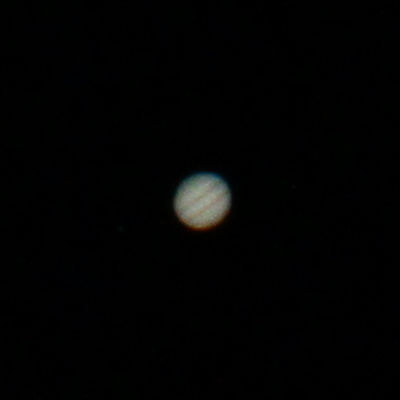 I did do a ‘proper’ exposure for Jupiter itself, as well, and captured a moderate amount of detail, at least for a telephoto lens and not a telescope. I have a goal to capture the Great Red Spot, but it won’t happen with this rig, especially as the spot is shrinking and fading now. It wasn’t visible at this time anyway, but Jupiter rotates pretty damn fast and typically it will become visible at some point throughout an evening (I believe it starts coming into view around 3:15 AM, about 90 minutes from now as I type this.)
I did do a ‘proper’ exposure for Jupiter itself, as well, and captured a moderate amount of detail, at least for a telephoto lens and not a telescope. I have a goal to capture the Great Red Spot, but it won’t happen with this rig, especially as the spot is shrinking and fading now. It wasn’t visible at this time anyway, but Jupiter rotates pretty damn fast and typically it will become visible at some point throughout an evening (I believe it starts coming into view around 3:15 AM, about 90 minutes from now as I type this.)
By the way, since they’re at the same resolution, you can compare the apparent sizes of Jupiter here and Saturn above, and know that Saturn is almost twice the distance from Jupiter than Jupiter is from the sun. The rocky bodies (Mercury, Venus, Earth, Mars) are all clustered close to the Sun in the solar system, with the gas giants (Jupiter, Saturn, Uranus, Neptune) spreading way the hell out beyond that – the scales are mind-boggling.
[Meanwhile, a brief explanation of why I’m stalling on the telescope thing: In and of itself, it’s a lot fussier to set up than the long lens and tripod, but should I desire to use the tracking motor, that has to be aligned with true north and is fussier still. Plus the scope needs to be allowed to reach something close to ambient air temperature, which means at least a half-hour when the temperature is as drastically different from indoors as it is tonight – it’s about 10° C right now, and dropping fast. Then, I can set about collimating/focusing it to actually get a clear view, and with the temperature changing, re-collimation would probably be necessary every 20 minutes or so. Essentially, I have to be psyched to spend a few hours on a dedicated session, and I just haven’t gotten motivated to that point yet – and if I’m going to do it, I’m going to do it in a much darker sky area than this, so that means traveling to a good spot too.]
Anyway, while I was out and actually pressing the shutter release, I thought I’d check on another subject that I’d been seeing.
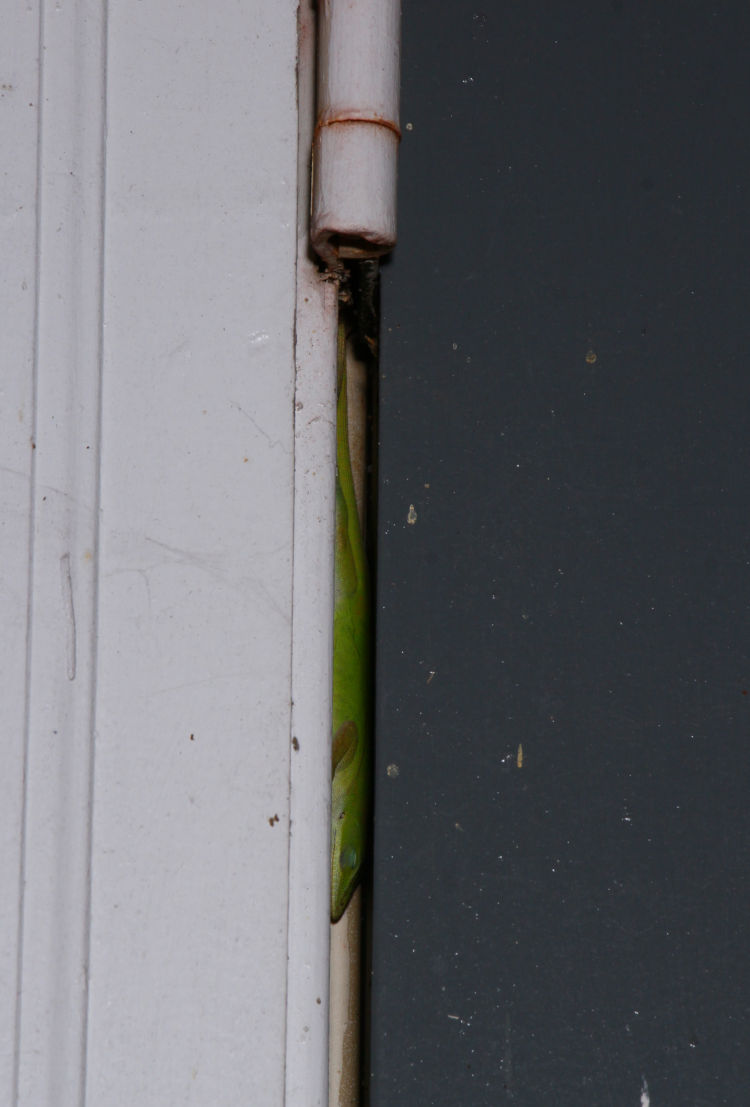
I’ve seen only one Carolina anole (Anolis carolinensis) in the past few weeks during the days, but when I think to check at night, I usually find this guy tucked into the crack of the door into the crawlspace of the house – immediately inside is the water heater, while a bit deeper is the house heater, so there’s some residual heat leaking out that it’s taking advantage of. How much longer this will go on I can’t say, though this may be the last I see of the species this year, unless one sneaks into the greenhouse. It’s funny – I saw this behavior plenty of times last fall, then not again until abut two weeks ago. As the conditions warrant, I guess.
I wanted to do this shot too while I was out.
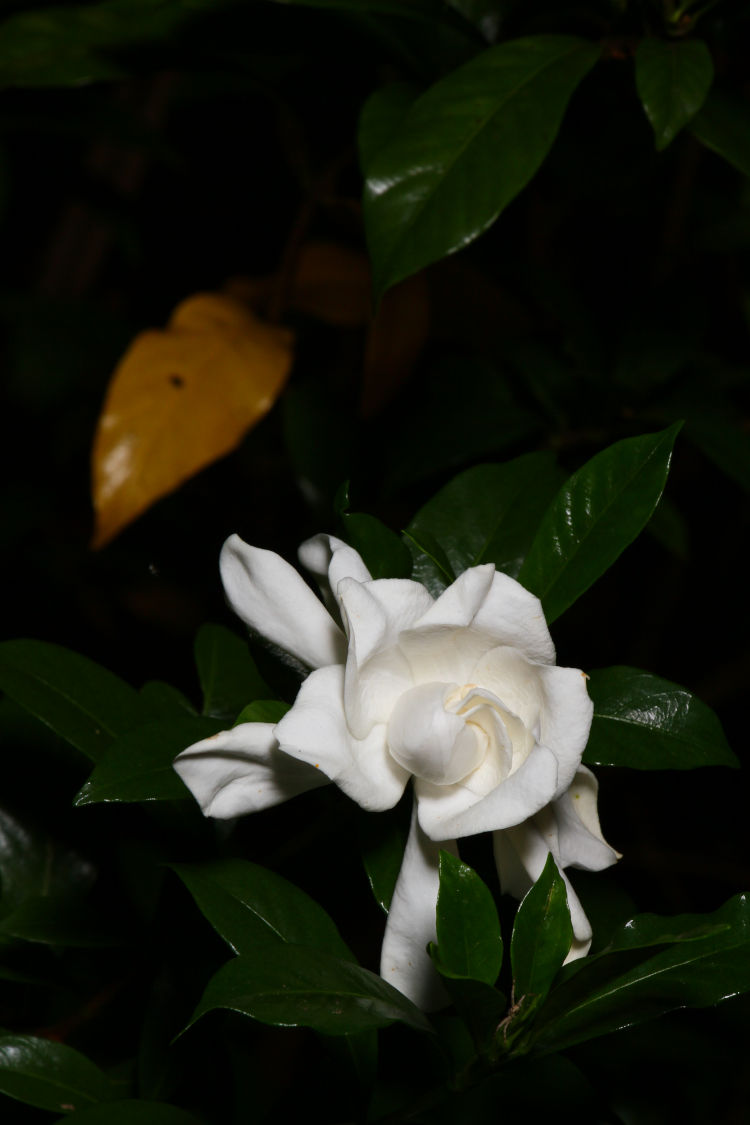
Two of the three gardenia plants in the Back Forty thought that the recent rains, coming as they did after a long hot drought, heralded a second spring and blossomed out – not exuberantly, but we have a handful of flowers even as autumn is beginning to settle in, which the background leaves indicate. And just now, I noticed the spider down at the bottom of the frame.
But then I went around the same bush for a different perspective on another flower and made a more surprising discovery.

From my initial angle, the white stripe on the side was the only thing I could see, wondering what it was, until it resolved itself into a green treefrog (Dryophytes cinereus.) I tried a few frames, but overhanging leaves always prevented good light from reaching the frog. I’ve been seeing these a little more frequently than the anoles, true, and they seem slightly more cold-hardy, but it’s about time for them to tuck into someplace safe for the season. The winter slump is arriving, but hopefully I’ll get a few more pics of interest before it gets a firm toehold. We’ll see.
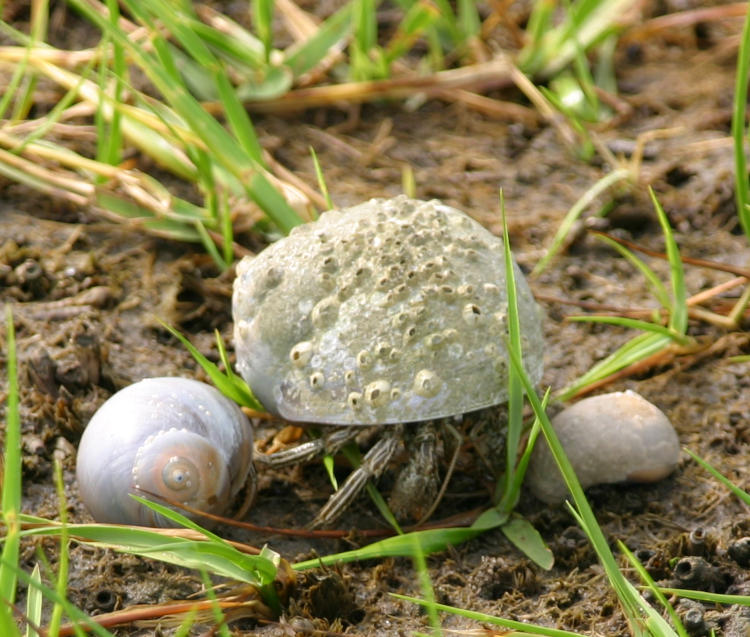























































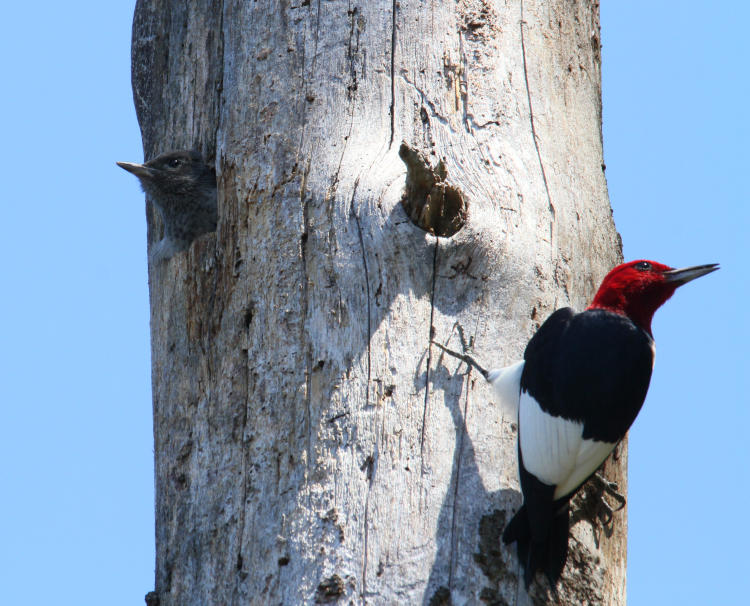




 I had checked Stellarium before I went out, to be sure I wasn’t missing something cool like the ISS passing in front of the moon, and so I knew that the semi-bright star just above the moon was actually Saturn, and thus shot a few frames of that. This is also full resolution, so you can compare it in size to Bullialdus – I could just barely make out the oval nature of the planet in the viewfinder. But I admit that I used the moon to focus sharply, chimping at the image previews under high magnification to try and get the sharpest pic possible. Saturn is a whole lot dimmer than the moon, so while the Bullialdus frame immediately above is 1/125 second at f8, ISO 800, the image of Saturn at right is at 1/13 second, f8, ISO 3200 – over five times brighter. And Saturn’s moons still aren’t visible.
I had checked Stellarium before I went out, to be sure I wasn’t missing something cool like the ISS passing in front of the moon, and so I knew that the semi-bright star just above the moon was actually Saturn, and thus shot a few frames of that. This is also full resolution, so you can compare it in size to Bullialdus – I could just barely make out the oval nature of the planet in the viewfinder. But I admit that I used the moon to focus sharply, chimping at the image previews under high magnification to try and get the sharpest pic possible. Saturn is a whole lot dimmer than the moon, so while the Bullialdus frame immediately above is 1/125 second at f8, ISO 800, the image of Saturn at right is at 1/13 second, f8, ISO 3200 – over five times brighter. And Saturn’s moons still aren’t visible.

 I did do a ‘proper’ exposure for Jupiter itself, as well, and captured a moderate amount of detail, at least for a telephoto lens and not a telescope. I have a goal to capture the Great Red Spot, but it won’t happen with this rig, especially as the spot is shrinking and fading now. It wasn’t visible at this time anyway, but Jupiter rotates pretty damn fast and typically it will become visible at some point throughout an evening (I believe it starts coming into view around 3:15 AM, about 90 minutes from now as I type this.)
I did do a ‘proper’ exposure for Jupiter itself, as well, and captured a moderate amount of detail, at least for a telephoto lens and not a telescope. I have a goal to capture the Great Red Spot, but it won’t happen with this rig, especially as the spot is shrinking and fading now. It wasn’t visible at this time anyway, but Jupiter rotates pretty damn fast and typically it will become visible at some point throughout an evening (I believe it starts coming into view around 3:15 AM, about 90 minutes from now as I type this.)






